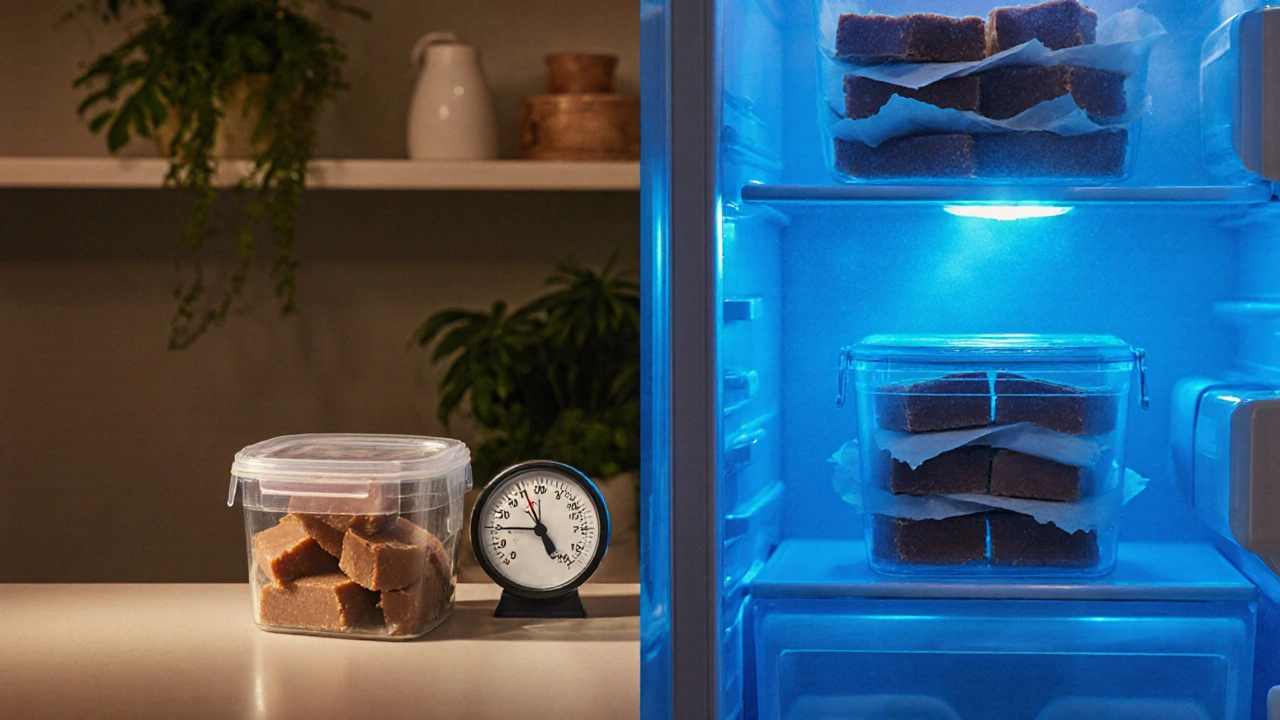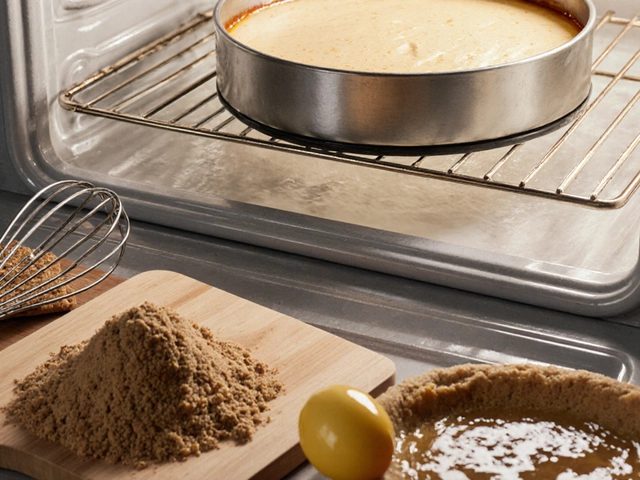
Fudge Refrigeration Calculator
Storage Recommendation
You made a batch of rich, gooey fudge using condensed milk-sweet, smooth, and perfect for gifting or snacking. But now you’re staring at it on the counter, wondering: does fudge made with condensed milk need to be refrigerated? The answer isn’t as simple as yes or no. It depends on how you plan to store it, how long you want it to last, and even the climate you live in.
Why Condensed Milk Changes the Rules
Most traditional fudge recipes use sugar, butter, and chocolate, and they’re fine at room temperature for weeks. But when you swap in sweetened condensed milk, you’re adding a lot more moisture and sugar syrup. That’s great for texture-it makes the fudge creamy and soft-but it also makes it more vulnerable to spoilage.Condensed milk is about 40% water, even though it’s been boiled down. That water doesn’t just disappear when you cook the fudge. Some stays locked in, especially if you don’t cook the mixture long enough or if you stir it too much after it cools. That moisture can encourage mold or bacteria growth over time, especially in warm, humid places like Auckland in summer.
Room Temperature Storage: When It’s Okay
If you’re planning to eat your fudge within 5 to 7 days, and you live in a cool, dry environment, you can leave it out. Store it in an airtight container, layered with parchment paper to prevent sticking. Keep it away from direct sunlight and heat sources-like a windowsill or near the oven.I’ve left condensed milk fudge on the kitchen counter for a week in April, when it was still cool and dry here in Auckland. It stayed fine-no stickiness, no mold, no off smells. But that was the exception, not the rule.
When Refrigeration Is Necessary
If you live in a warm or humid climate-or if you’re making fudge during summer months-refrigeration is your best friend. Humidity causes fudge to absorb moisture from the air, turning it sticky and grainy. Heat speeds up spoilage. In places like Florida, Texas, or even Auckland in January, leaving fudge out for more than 2 days is asking for trouble.Refrigerating fudge made with condensed milk slows down mold growth and keeps the texture firm and sliceable. It also helps the flavors meld better over time. Many professional bakers in New Zealand and Australia refrigerate their condensed milk fudge for at least 24 hours before cutting, not just to set it, but to preserve it.
How to Refrigerate Fudge Right
Don’t just toss it in the fridge uncovered. That’s a recipe for odor transfer and drying out. Here’s how to do it right:- Let the fudge cool completely at room temperature. This takes about 2 hours.
- Cut it into squares or bars.
- Place each piece in an airtight container, separated by parchment paper.
- Seal the container tightly and label it with the date.
- Store in the coldest part of the fridge-usually the back, not the door.
Properly stored, refrigerated fudge lasts 2 to 3 weeks. Some batches I’ve made in late October 2025 still tasted fresh after 21 days.

Can You Freeze It?
Yes-and if you’re making a big batch for gifts or holidays, freezing is the smart move. Frozen condensed milk fudge keeps for up to 3 months without losing quality.Freeze it the same way you refrigerate it: cut, layered with parchment, sealed tight. Thaw it in the fridge overnight before serving. Don’t thaw at room temperature-condensation will make the surface wet and dull the texture.
Signs Your Fudge Has Gone Bad
Even with proper storage, things can go wrong. Watch for these red flags:- Visible mold-fuzzy spots in white, green, or blue
- Unusual smell-sour, yeasty, or alcoholic
- Texture change-excessively sticky, grainy, or oily
- Separation-oil pooling on the surface
If you see any of these, toss it. No amount of scraping or reheating will make spoiled fudge safe.
Why Some People Say It Doesn’t Need Fridge
You might have heard that fudge doesn’t need refrigeration because it’s high in sugar, and sugar acts as a preservative. That’s true-but only up to a point. Sugar pulls water away from microbes, which slows them down. But condensed milk fudge has more water than traditional fudge, and the sugar isn’t concentrated enough to fully counteract it.Also, many online recipes don’t mention refrigeration because they assume you’ll eat the fudge fast. They’re not thinking about humidity, storage times, or gift-giving. Don’t rely on those tips if you’re not eating it within 48 hours.
What About Fudge with Add-Ins?
If you’ve added nuts, dried fruit, marshmallows, or chocolate chips, the storage rules get even more specific.- Nuts: Can go rancid at room temperature after 10 days. Refrigerate if storing longer.
- Dried fruit: Can absorb moisture and become chewy or moldy. Refrigeration helps.
- Marshmallows: Turn sticky and slimy if left out. Always refrigerate.
- Chocolate chips: May bloom (develop white streaks) in the fridge, but that’s harmless-it’s just cocoa butter rising. The taste is unchanged.
When in doubt, refrigerate. It’s safer and keeps everything tasting better.
Final Rule of Thumb
Here’s what I always tell people who ask: If you’re not eating the fudge within 3 days, put it in the fridge. If you’re making it for Christmas, Valentine’s Day, or a birthday gift, freeze it. It’s the only way to guarantee it’ll look and taste amazing when it’s opened.Condensed milk fudge is too good to waste. A little extra care in storage means you get to enjoy it longer, with the same rich, creamy texture you worked hard to make.
Can I leave fudge made with condensed milk out overnight?
Yes, if it’s just for one night and your kitchen is cool and dry. But if the temperature is above 22°C (72°F) or the air feels humid, it’s better to refrigerate it. Overnight exposure won’t ruin it, but it increases the risk of stickiness or spoilage over the next few days.
Why does my fudge get grainy after refrigeration?
Graininess usually happens when the fudge is stirred too much after it’s removed from heat. The sugar crystals form unevenly. Refrigeration doesn’t cause graininess-it just makes it more noticeable. To avoid it, let the fudge cool undisturbed for 15-20 minutes before stirring, and never stir once it starts to thicken.
Does refrigerating fudge make it harder to cut?
Actually, it makes it easier. Cold fudge holds its shape better. Use a sharp knife dipped in hot water and wiped dry between cuts. This gives you clean, smooth edges without crumbling or sticking.
Can I store fudge in the pantry if it’s sealed in a vacuum bag?
Vacuum sealing helps, but it doesn’t eliminate moisture from the condensed milk. In warm or humid climates, vacuum-sealed fudge can still develop mold in 5-7 days. For safety and texture, refrigeration is still the better choice, even with vacuum sealing.
How long does fudge made with condensed milk last in the freezer?
Properly wrapped and stored, it lasts up to 3 months. After that, it may start to absorb freezer odors or lose some of its creamy texture. For best results, use it within 2 months and always thaw in the fridge-not on the counter.
Next Steps: What to Do With Your Fudge
If you just made a batch, here’s your quick action plan:- Wait 2 hours for it to cool completely.
- Decide: Will you eat it in 3 days? If yes, keep it in an airtight container on the counter. If not, refrigerate or freeze.
- Use parchment paper between layers to prevent sticking.
- Label the container with the date.
- If gifting, wrap each piece in cellophane and tie with a ribbon-it looks nicer and adds a little extra protection.
Fudge made with condensed milk is one of the easiest, most forgiving desserts you can make. But treat it with a little respect, and it’ll reward you with months of deliciousness-not just days.









Write a comment